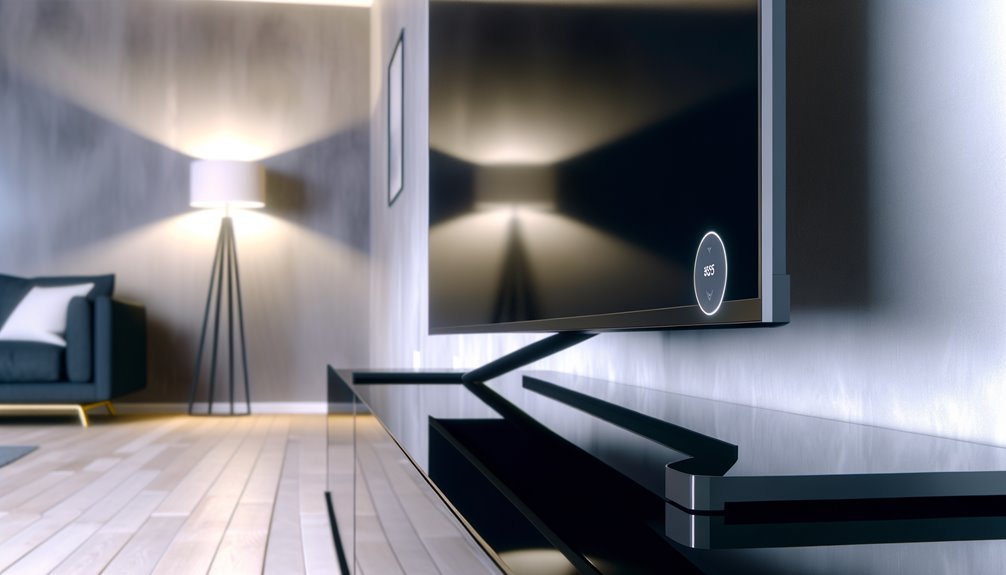Using an optical cable for your soundbar guarantees high-quality audio transmission with minimal interference. Start by plugging one end into your soundbar's optical input and the other into your TV's optical output. Power both devices on and set the correct input source. This setup promises clean, clear audio and stable connectivity. While HDMI ARC offers advanced audio formats and two-way data transmission, optical cables are ideal for older devices or simpler setups. For peak performance, choose the appropriate cable length, clean the connectors regularly, and avoid sharp bends or high temperatures. Further insights await to perfect your configuration.
Key Information
- Fiber optics ensure high-quality audio transmission and are immune to electromagnetic interference.
- Connect the optical cable to the soundbar's optical input and the TV's optical output.
- Optical cables provide stable and reliable connectivity for a wide range of devices.
- Choose the right cable length based on the distance between the soundbar and audio source.
- Regularly clean and inspect the optical cable to maintain optimal performance.
Benefits of Optical Cables
By utilizing fiber optics, optical cables guarantee high-quality audio transmission that's immune to electromagnetic interference, providing you with a clean and clear audio signal. This makes them an excellent choice for your home theater system, ensuring that you experience every sound detail without distortion.
Their immunity to interference is particularly beneficial in environments with numerous electronic devices, where traditional cables might falter. Optical cables also boast compatibility with a wide range of devices, including TVs, soundbars, and gaming consoles. This versatility means you can easily integrate them into various setups.
Additionally, their stable and reliable connectivity ensures an enhanced audio experience, free from the common pitfalls of analog connections, such as signal degradation over distance.
How to Connect Your Soundbar
Connecting your soundbar using an optical cable involves a few precise steps to guarantee excellent audio performance.
First, connect one end of the optical cable to the soundbar's optical input port.
Next, plug the other end into the optical output on your TV or audio source.
Make sure both the soundbar and the TV are powered on and set to the correct input source.
Utilize the remote or control panel on the soundbar to select the optical input.
Confirm the connection by checking the TV's audio settings if necessary.
Once these steps are completed, you'll enjoy high-quality audio from your TV through the soundbar, thanks to the optical connection.
Optical Vs. HDMI
When comparing optical cables to HDMI connections for soundbars, it's important to understand their distinct advantages and limitations. HDMI ARC is typically preferred because it transmits both audio and video through a single cable, offering two-way data transmission capabilities that enhance user experience. This versatility supports advanced audio formats, like Dolby TrueHD, especially with HDMI eARC.
Optical cables, on the other hand, are ideal for older devices or setups lacking HDMI ARC. Though both options support digital audio, including stereo and 5.1 surround sound, HDMI ARC generally delivers superior audio quality. For the best audio experience and compatibility with modern formats, HDMI ARC or eARC is recommended over optical connections.
Choosing the Right Length
Once you've decided between optical and HDMI for your soundbar, it's important to select the right cable length to guarantee ideal placement and performance.
Consider the following factors:
- Distance: Measure the distance between your soundbar and the audio source. This ensures you select a cable long enough without creating tension.
- Room Layout: Opt for a longer cable if you need to route it around walls or furniture, providing flexibility for larger or more complex setups.
- Clutter Reduction: Choose a shorter cable for minimalistic setups to reduce clutter and excess cable length, maintaining a clean aesthetic.
Customizable lengths can offer tailored solutions, ensuring your audio setup is both functional and visually appealing without unnecessary slack or strain.
Maintenance Tips
Maintaining your optical cable's integrity is crucial for ensuring consistent sound quality and longevity.
Regularly clean the connectors using a soft cloth to remove dust and debris, which can interfere with signal transmission.
Avoid sharp bends in the cable to protect the delicate fiber optics inside.
Store your cable coiled loosely to prevent kinks and maintain its flexibility.
Inspect the cable frequently for any signs of wear or fraying; these can compromise performance.
Additionally, keep your optical cable away from heat sources and direct sunlight to prevent damage to the outer casing.
Frequently Asked Questions
What Does an Optical Cable Do for a Soundbar?
An optical cable transmits high-quality digital audio signals from your TV to your soundbar. It guarantees clear, crisp sound by using light signals, which are immune to electromagnetic interference, enabling formats like Dolby Digital or DTS.
Is It Better to Connect Soundbar With HDMI or Optical?
Connecting your soundbar with HDMI ARC is better due to streamlined setup, two-way data transmission, and support for higher-quality lossless audio formats like Dolby TrueHD. Opt for optical if HDMI ARC isn't available or for older devices.
How Do I Connect My Soundbar to My TV With an Optical Cable?
Locate the optical audio output on your TV and soundbar. Insert one end of the optical cable into the TV's output and the other into the soundbar's input. Power on both devices and select the optical input.
Is Optical Cable Better for Sound?
Yes, optical cables are better for sound. They transmit high-quality digital audio signals without interference, ensuring crystal-clear sound. They're immune to electromagnetic interference, easy to set up, and compatible with various devices, enhancing your overall audio experience.
Conclusion
To sum up, choosing the appropriate optical cable for your soundbar can greatly enhance audio quality. Make sure you select the correct length to avoid unnecessary slack or tension.
Regular maintenance, such as dusting the connectors, will extend your cable's lifespan.
While HDMI offers additional features, optical cables provide reliable, high-fidelity sound.
By following these guidelines, you'll optimize your audio setup for the best listening experience. Your soundbar's performance will be noticeably improved with the right optical cable.



